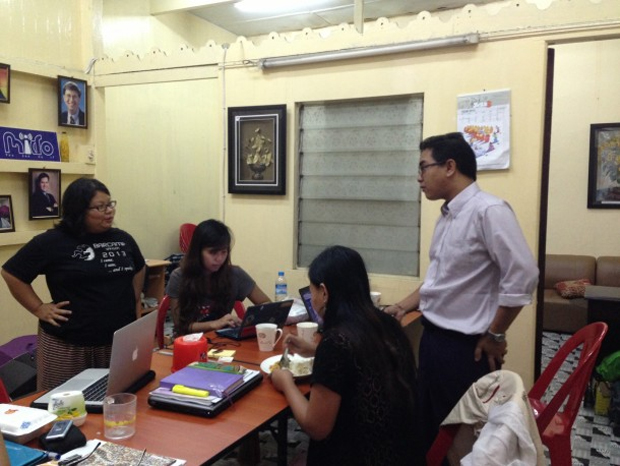|
 |
Quality of Life
Social sector
Development of social sector has kept pace with economic development expansion of schools and institutions of higher education have been considerable especially in the States and Divisions. Adult literacy rate for the year 2003 was 91.9 percent with 94.8 percent for male and 89.4 percent for female. Expenditure for health and education have raised considerably, equity and access to health and education and social services has been ensured all over the country. Government has increased health spending on both current and capital yearly. Total government health expenditure increased form kyat 464.1 million in 1988-89 to kyat 24851.5 million in 2004-05. The estimation of total national health expenditure for the year 2001-02 was estimated to be kyat 87853.9 million on equivalents to 2.5 percent of GDP.
Healthcare
Ministry of Health is the main organization of health care provision. It is organized into 7 departments – Department of Health Planning, Department of Health, Department of Medical Science, Department of Medical Research (lower Myanmar), Department of Medical Research (Upper Myanmar), Department of Medical Research (Central Myanmar) and Department of Traditional Medicine each of which is headed by Director-General. Department of Health plays a major role in providing comprehensive health care throughout the country including remote and hard to reach border areas. Various Types of health facilities exists at different levels. At the rural community level, there are Rural Health Center (RHC) staffed by a Health Assistant, Lady Health Visitor and Midwife and Sub-center run by Midwife and Public health Supervisor grade II (PHS II). In addition, there are basic voluntary health workers (Community Health Worker and Auxiliary Midwives) providing outreach services to village hamlets. At the first referral level, in urban areas are Township Hospitals with a Medical Officer (TMO) and allotted quota of health personnel. The Township Hospitals have 16, 25 or 50 beds depending on the population. Each Township has at least 1-2 Station Hospitals with one Medical Officer and other health staff and 4-7 Rural Health Centers under the jurisdiction. The second referral level is the District Hospitals which are equipped by specialist services. At the tertiary referral level are the State/Division General Hospitals, and Teaching and Specialist Hospitals, which have all specialties, better facilities and more staff. To promote the sectorial collaboration and community participation in health development activities, the National Health Committee (NHC) was formed in 1989. The National Health Committee is a high-level inter-ministerial and policy making body, which provide leadership and guidance in implementation of systematic efficient health programs.
Human resources development
The Department of medical Science is concerned with the production of all categories of health personnel with the aims to strengthen the development of human resources for health and equip them with advanced technologies. The type of health personnel produced are doctors, dental surgeons, nurses (including specialty nurses) paramedics, pharmacists, dental technicians and basic health workers such as health assistants, public health supervisor grade I and II, lady health visitors and midwives who are the cornerstone for the implementation of rural health development program.
Skilled health staff is critical for delivery of quality health care to mothers and children. As not all necessary tools are available to support training and ongoing development of health worker skills, it will be necessary to development and adapt technical training materials, guidelines, and standards already existing at the international level. A training course is currently being developed for the integrated management of pregnancy and childbirth at primary health care level, which will teach the use of the job-aid on Pregnancy, Childbirth, Postpartum, and Newborn care (WHO et al 2004). Training on the use of job-aid will supplemented, at the rural health center level and above, by using the WHO midwifery modules (WHO 1996).
Community Services
With regard to self-help organizations Yangon Deaf Association and Mandalay Deaf Association have been formed. Moreover the disabled persons who have been trained at AAR training center have formed Self-Help Group to stand on their own feet, to raise up PWDs development groups, which has over 60 disabled persons. AAR planned and support the graduates economically, morally and socially (Eg. Setting up a business net working with other graduates to exchange knowledge and experiences.) The emergence of Self-Help Organizations (SHOs) and Self-Help Groups (SHGs) empowered PWDs to help each other and be independent. These has encouraged many PWDs organize themselves into different groups according to their type of disabilities, some (SHGs) with cross disabilities and help each other. For disabled female persons, the Zion center for the development of disabled women was established and it is located on the outskirts of Yangon. It is focused on providing employment for the disabled women. In addition to employment, this center brings disable individual from the community together socially, providing the opportunities for them to support and encourage each other who face the same straggles. At present World Vision International together with the Health Department is trying to develop CBR (Community Based Rehabilitation) projects. CBR program conducted by Health involve the community at the grass roots level recruiting local voluntary Health workers for the implementation of the programs. Apart from that Eden Handicap Service Center (NGO) started a CBR project in 2002. The Department of Social Welfare is trying to raise awareness to the general public regarding disability issues.
|















